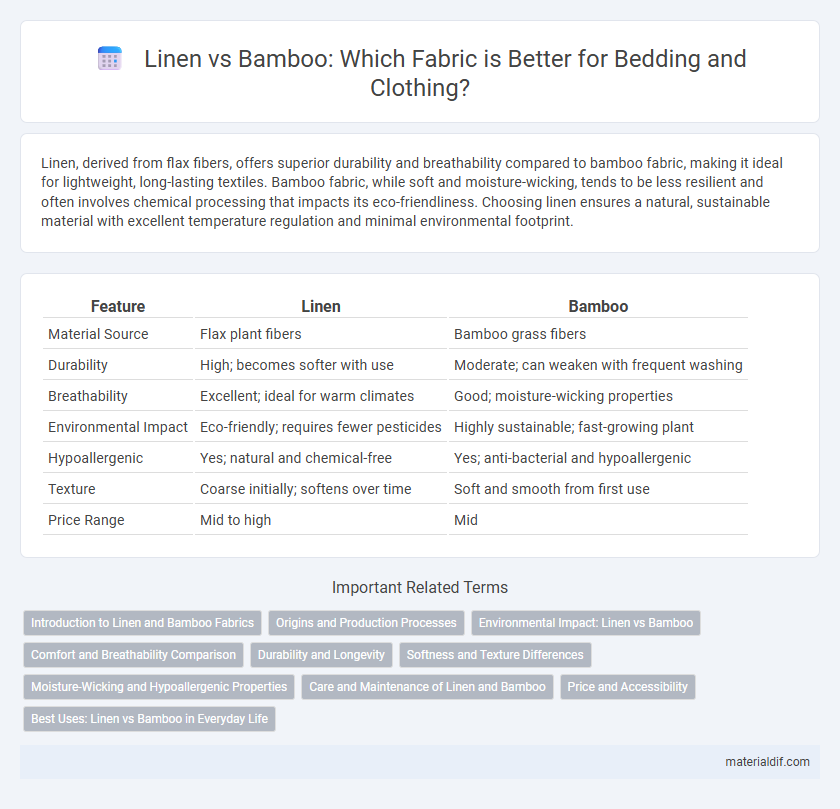Linen, derived from flax fibers, offers superior durability and breathability compared to bamboo fabric, making it ideal for lightweight, long-lasting textiles. Bamboo fabric, while soft and moisture-wicking, tends to be less resilient and often involves chemical processing that impacts its eco-friendliness. Choosing linen ensures a natural, sustainable material with excellent temperature regulation and minimal environmental footprint.
Table of Comparison
| Feature | Linen | Bamboo |
|---|---|---|
| Material Source | Flax plant fibers | Bamboo grass fibers |
| Durability | High; becomes softer with use | Moderate; can weaken with frequent washing |
| Breathability | Excellent; ideal for warm climates | Good; moisture-wicking properties |
| Environmental Impact | Eco-friendly; requires fewer pesticides | Highly sustainable; fast-growing plant |
| Hypoallergenic | Yes; natural and chemical-free | Yes; anti-bacterial and hypoallergenic |
| Texture | Coarse initially; softens over time | Soft and smooth from first use |
| Price Range | Mid to high | Mid |
Introduction to Linen and Bamboo Fabrics
Linen is a natural fiber made from the flax plant, renowned for its breathability, durability, and moisture-wicking properties, making it ideal for warm-weather clothing and home textiles. Bamboo fabric, derived from bamboo pulp, offers a soft texture with antibacterial and hypoallergenic qualities, favored for eco-friendly clothing and bedding. Both fabrics are sustainable options, but linen excels in strength and longevity, while bamboo outperforms in softness and antimicrobial benefits.
Origins and Production Processes
Linen fibers originate from the flax plant, cultivated primarily in Europe and value its eco-friendly, low-water cultivation process. Bamboo fibers come from the bamboo grass, mostly grown in Asia, but often undergo chemical processing to transform the raw plant into soft fabric. Linen's mechanical extraction preserves fiber strength and durability, whereas bamboo production frequently uses a chemical-intensive viscose method, impacting its environmental footprint.
Environmental Impact: Linen vs Bamboo
Linen production requires significantly less water and fewer pesticides compared to bamboo cultivation, which often involves intensive chemical processing to create soft textiles. Bamboo, despite its fast-growing nature, undergoes energy-intensive manufacturing processes that generate harmful emissions and waste. Choosing linen over bamboo supports more sustainable agriculture with lower carbon footprints and reduced environmental degradation.
Comfort and Breathability Comparison
Linen offers superior breathability due to its natural fiber structure, allowing air to flow freely and wick moisture away, keeping the wearer cool and dry. Bamboo fabric also provides excellent comfort with its soft texture and moisture-wicking properties, but linen's coarser fibers create a more breathable weave that enhances ventilation. Both materials are ideal for warm climates, but linen generally outperforms bamboo in ventilation and cooling effects.
Durability and Longevity
Linen outperforms bamboo fabric in durability due to its strong natural flax fibers that become softer yet maintain strength after each wash. Bamboo textiles, while eco-friendly and soft, tend to wear out faster with frequent use and laundering, reducing their longevity. Choosing linen ensures a longer-lasting, resilient fabric ideal for everyday textiles.
Softness and Texture Differences
Linen fibers, derived from flax plants, provide a crisp texture that becomes softer with each wash but retains a naturally textured feel. Bamboo fabric, made from bamboo pulp, offers a smoother, silkier softness that feels gentler against the skin. Linen's breathability and durability contrast with bamboo's moisture-wicking properties and enhanced softness, making each suited for different preferences in texture and comfort.
Moisture-Wicking and Hypoallergenic Properties
Linen excels in moisture-wicking due to its natural flax fibers that absorb and evaporate moisture quickly, keeping the skin dry and comfortable. Bamboo fibers are also moisture-wicking but tend to retain more moisture compared to linen, making linen superior in breathability. Both materials are hypoallergenic, but linen's breathability and antimicrobial properties reduce the risk of irritation more effectively than bamboo.
Care and Maintenance of Linen and Bamboo
Linen requires gentle washing in cool or lukewarm water with mild detergent to preserve its natural fibers, and it should be air-dried or tumble-dried on low heat to avoid shrinkage. Bamboo fabric, known for its smooth texture, is best cared for with delicate or hand washing in cold water and should be air-dried to maintain its softness and durability. Both textiles benefit from avoiding bleach and high heat to prolong fabric life and retain their eco-friendly properties.
Price and Accessibility
Linen is generally more expensive than bamboo due to the labor-intensive process of extracting fibers from flax plants, resulting in higher production costs. Bamboo fabric tends to be more affordable and widely accessible, as bamboo grows quickly and requires less water and pesticides, making it a sustainable option with lower manufacturing expenses. Availability of linen is often limited to specialty stores, while bamboo textiles are commonly found in mass-market outlets and online retailers.
Best Uses: Linen vs Bamboo in Everyday Life
Linen excels in durability and breathability, making it ideal for bedding, tablecloths, and summer clothing, while bamboo's natural moisture-wicking and antibacterial properties suit activewear and towels. Linen's textured, breathable fabric is favored for stylish home textiles and casual garments, whereas bamboo offers softness and flexibility perfect for sensitive skin products and eco-friendly apparel. Both materials support sustainable living, but linen thrives in long-lasting household items, while bamboo performs well in moisture-prone and skin-contact uses.
Linen vs Bamboo Infographic

 materialdif.com
materialdif.com